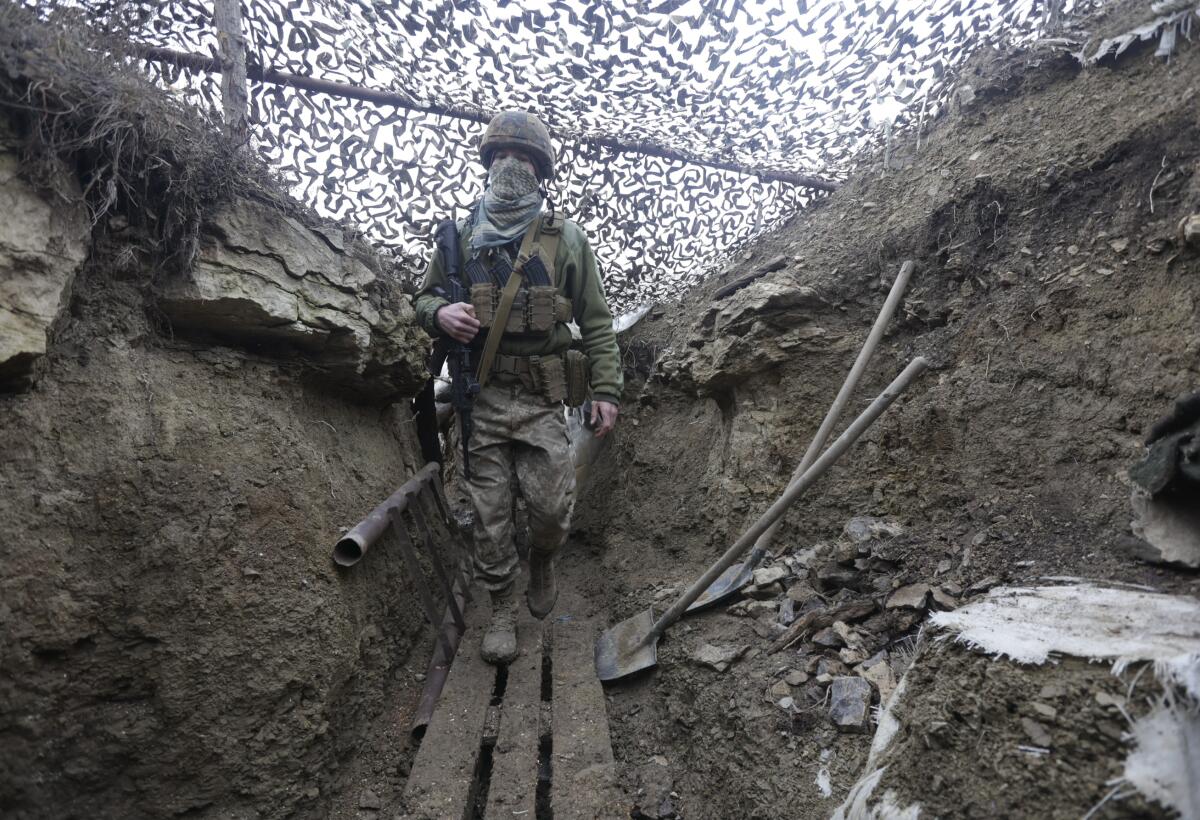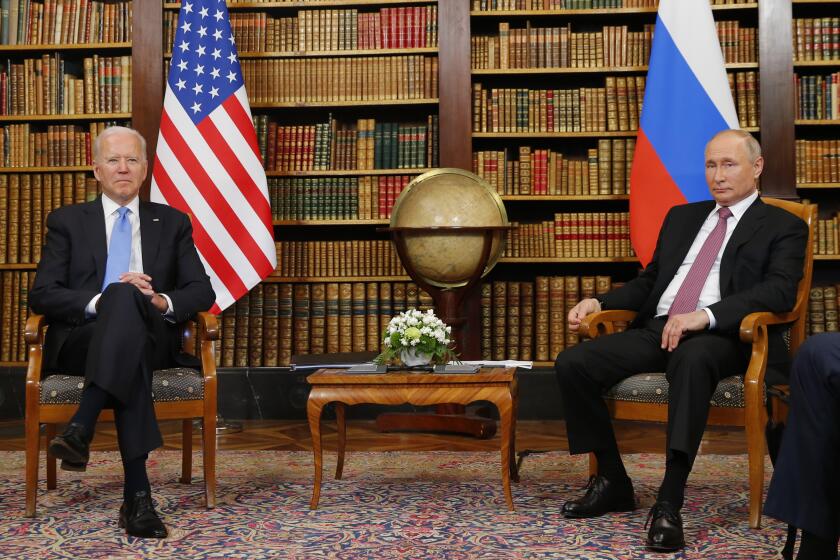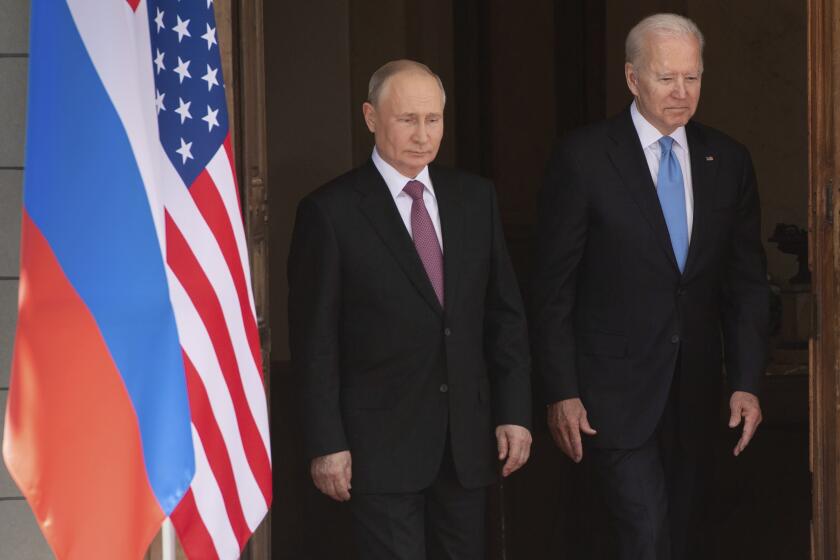Op-Ed: How the U.S. could help prevent the Russia-Ukraine crisis from morphing into war

- Share via
After Russia precipitated a crisis by amassing upward of 100,000 troops around Ukraine, the standoff was only expected to intensify. The prevailing assumption was that Russian President Vladimir Putin would maintain the pressure in order to retain leverage as American and Russian officials prepare for their Jan. 10 talks in Geneva.
Then a sliver of good news seemed to appear when Putin was reported to have ordered an estimated 10,000 of those troops back to their bases in southern Russia on Saturday. These media accounts are in dispute. If true, the move could be a gesture acknowledging President Biden’s decision to defer the planned $200-million weapons package to Ukraine, shipments of small arms and ammunition aside.
Even if the pullback did occur, Putin still has plenty of forces deployed near Ukraine, so the crisis continues.
Two of the various recent proposals aimed at preventing an armed confrontation between Russia and Ukraine stand out, even though neither will resolve the crisis.
The first year has not been kind to the efforts of senior U.S. officials in charge of foreign policy — or to President Biden.
The first advocates beefing up Ukraine’s army with substantial supplies of American weaponry, particularly anti-tank and air defense missiles, and dispatching additional advisors to ensure that Ukrainian soldiers are ready to use the armaments in short order. Here’s an extravagant version of this idea: a massive airlift like the one the United States started in 1948 to ensure the flow of basic necessities to West Berlin after the Soviet leadership blocked the transportation routes connecting it to the West.
Those demanding additional American arms be dispatched to Ukraine insist that Putin will be deterred only when he’s convinced that the West will stand by it.
The second, less dangerous plan: creating a neutral Ukraine that won’t join the North Atlantic Treaty Organization or become Russia’s ally. Those pushing this approach point to the May 1955 Austrian State Treaty. That accord led to the withdrawal of allied occupation forces (American, British, French and Russian) on the understanding that Austria would declare itself a neutral state, which its parliament did that October, once all foreign troops had departed. During the Cold War, Austria stayed out of NATO and the Soviet-led Warsaw Pact — and became a prosperous democracy as well.
Advocates of Ukrainian neutrality invoke other successful examples, such as Finland during the Cold War. “What’s not to like?” they ask, adding that Ukraine’s entry into NATO is a distant prospect in any event.
The U.S. has supplied Ukraine with $2.5 billion in arms since 2014 — including $400 million in 2021 alone — and American soldiers have been training its army since 2015. Those calling for additional arms deliveries to Ukraine mistakenly assume that its army can rapidly absorb massive amounts of advanced weaponry and that American military advisors could quickly train Ukrainian soldiers to use them in battle.
They discount the prospect that Russia could call Washington’s bluff, leaving the U.S. with two bad choices: standing aside to avoid war with Russia and allowing Ukraine’s defeat, or riding to its rescue and risking a clash with Russia that could spin out of control — and end in an American defeat given that the fighting would occur on Russia’s doorstep.
Advocates of an airlift assume that Russia would stand by while the U.S. completes an aerial supply operation to make Ukraine’s army more muscular.
Paradoxically, rushing arms to Ukraine in hopes of protecting it could end up endangering the country by triggering a Russian attack. And far from boosting American credibility, it will end up eroding it. Having armed Ukraine, the United States will not go further and save it from defeat if that requires fighting Russia. That is the harsh reality.
To Americans, the end of the Soviet Union 30 years ago is a done deal. To Putin, it’s a catastrophe he longs to reverse.
The neutrality proposal, by contrast, has a significant advantage: It won’t increase the probability of war. Yet given the prevailing circumstances, it won’t work either. Austria and Finland accepted neutrality voluntarily. The Ukrainian government will not abandon its aspiration to join NATO, which has been enshrined in the country’s constitution since 2019. What’s more, neither NATO nor Biden would compel it become neutral. The White House has said as much.
A neutral Ukraine would satisfy Putin, but Biden would face fierce political blowback at home — and not just from Republicans — in the (unlikely) event that he yields to Putin’s demand that Ukraine forswear NATO and strongarms Ukraine into accepting neutrality. He would also divide NATO and risk public criticism, particularly from Poland and the Baltic trio, strong supporters of Ukraine’s quest to join the alliance.
There’s a third solution, albeit one that would require big concessions by Ukraine and Russia.
The 1995 Study on NATO Enlargement, which specified the terms for admitting new members, states that they should first resolve “ethnic disputes or external territorial disputes” involving them. This provision, while not phrased as a precondition, could nevertheless be invoked to defer Ukraine’s entry into the alliance indefinitely — but without shutting the door forever.
In exchange, Russia would acknowledge Ukraine’s inherent right of self-defense, per the United Nations Charter, including the freedom to acquire arms and receive military training from countries of its choosing. Ukraine would reciprocate by pledging not to permit Western military bases in its territory — Russia has denounced the U.S.-financed expansion of the Ukrainian Black Sea ports of Ochakiv and Mykolaiv to accommodate American warships — and to extend that ban to NATO members’ military aircraft and cruise or ballistic missiles. In return, Russia would agree to a demilitarized zone along its side of the Ukrainian border.
This formula doesn’t amount to a comprehensive settlement of the Russia-Ukraine dispute, but it could give each side something to tout as success while tamping down the immediate crisis.
Rajan Menon is a professor of international relations at City College of New York, director of the grand strategy program at Defense Priorities, and a senior research scholar at the Saltzman Institute of War and Peace Studies at Columbia University.
More to Read
A cure for the common opinion
Get thought-provoking perspectives with our weekly newsletter.
You may occasionally receive promotional content from the Los Angeles Times.












